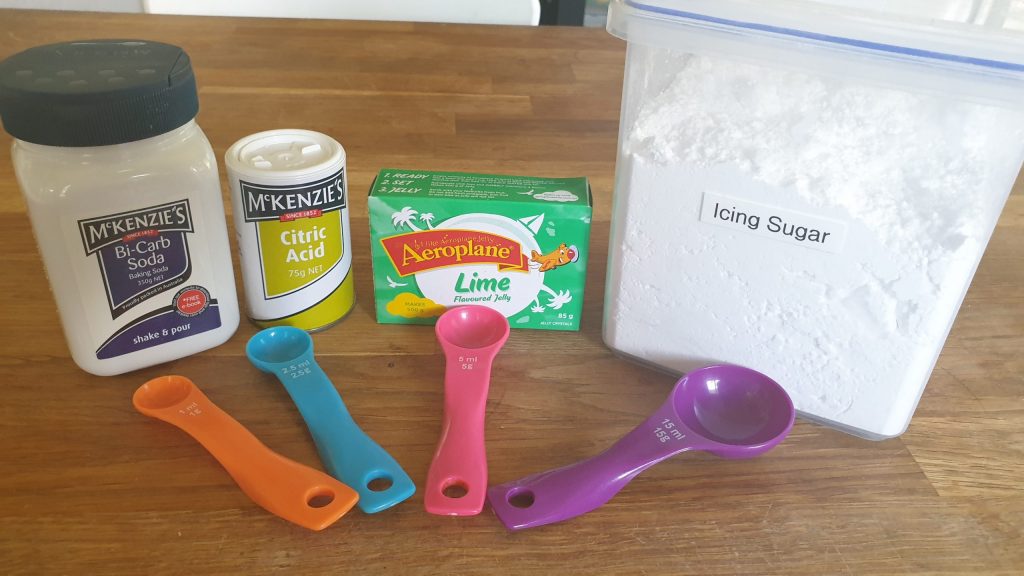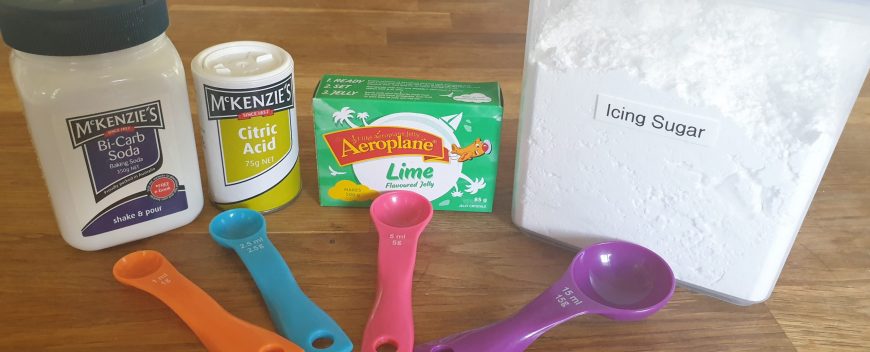Materials
- Icing sugar
- Jelly crystals
- Bicarbonate of soda (bicarb)
- Citric acid
- Small bowl or container with lid
- Measuring spoons (tablespoon and teaspoon)

Safety First!
- Always wash your hands before and after preparing food (yes, this is a science experiment, but you do get to eat it too!).
- If you have any food allergies, intolerances or aversions, make sure to check that all products you use are safe for you to eat.
- Citric acid and bicarb may cause mild irritation if you get them in your eyes. Take care not to rub your eyes while making your sherbet.
Instructions
- Mix together the sherbet ingredients using the following measurements:
- 1 tablespoon icing sugar
- 1 teaspoon jelly crystals
- 1/2 teaspoon citric acid
- 1/4 teaspoon bicarbonate of soda
A little bit of sherbet goes a long way, but if you’d like to make a bigger batch, just double the quantities given.
- Stir thoroughly, breaking up any clumps. If your container has a tight lid, put it on and shake the container to mix it.
- Taste your sherbet and adjust the ingredients to taste. You should only add tiny amounts when adjusting, and mix thoroughly before tasting again.
- Citric acid is very sour – it’s what gives lemons and other citrus fruits their sour taste. If your sherbet is too sour, add a tiny bit more bicarb.
- Bicarb on its own tastes soapy and bitter, so if this taste is overpowering, add more citric acid.
- Icing sugar is just very finely ground sugar. If your sherbet isn’t sweet enough, add a bit more.
- Jelly crystals are a combination of sugar, gelatine, flavouring, and colouring. Add a bit more to give your sherbet a flavour boost.
What's happening?
Sherbet gets its delightful fizz from the combination of citric acid and bicarbonate of soda, otherwise known as bicarb. Citric acid, as its name suggests, is an acid, while bicarb belongs to another group of chemicals known as bases.
When we mix an acid and a base together, we get a chemical reaction. In a chemical reaction, the molecules of the starting chemicals (known as reactants) break apart and reform into new chemicals (known as products). In this case, the new chemicals formed are water, sodium citrate (a type of salt), and carbon dioxide gas, which escapes as tiny bubbles. We can’t see all this going on, but the bubbles of gas give us a clue that a chemical reaction has taken place.
But our sherbet didn’t fizz as soon as we added the two dry chemicals together. In powder (solid) form, the chemicals can’t mix together as easily as when they are dissolved. When you add water, or put the sherbet in your mouth with your saliva, the citric acid and bicarb molecules can find each other more easily and react.
A chemical that helps a reaction happen, but isn’t itself changed by the reaction, is called a catalyst – in this case, water is a catalyst that helps the reaction between citric acid and bicarb to happen.
The other two ingredients in our sherbet – icing sugar and jelly crystals – are just there to make it taste yummy. They aren’t needed for the chemical reaction, but sherbet made from just citric acid and bicarb wouldn’t taste very nice.
Check your understanding
- Which two ingredients in the sherbet are involved in the chemical reaction?
- Which ingredients are not involved?
- Can you think of any other chemical reactions that might happen in the kitchen?
- Measure how many teaspoons of icing sugar it takes to fill up a tablespoon. A teaspoon is 5 millilitres (ml) – how many ml are in a tablespoon?
- How many teaspoons of sherbet does this recipe make?
- Calculate how much of each ingredient you would need if you used a metric cup (250ml) of icing sugar.
- Explain your understanding of the following scientific terms: chemical, chemical reaction, molecule, reactant, product, catalyst.
Curriculum Links
- Year 2 Chemical Sciences: Different materials can be combined for a particular purpose (ACSSU031)
- Year 6 Chemical Sciences: Changes to materials can be reversible or irreversible (ACSSU095)



